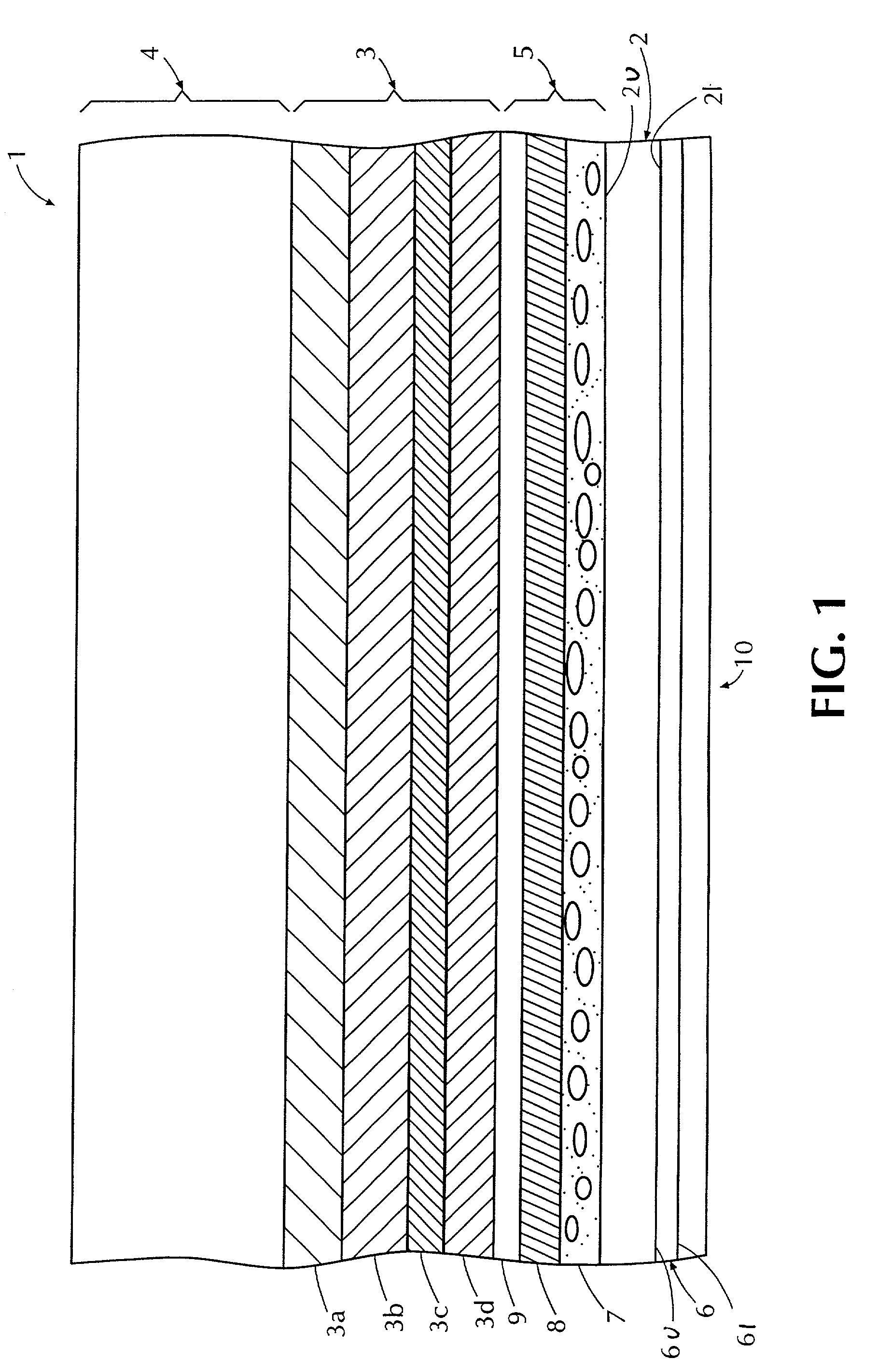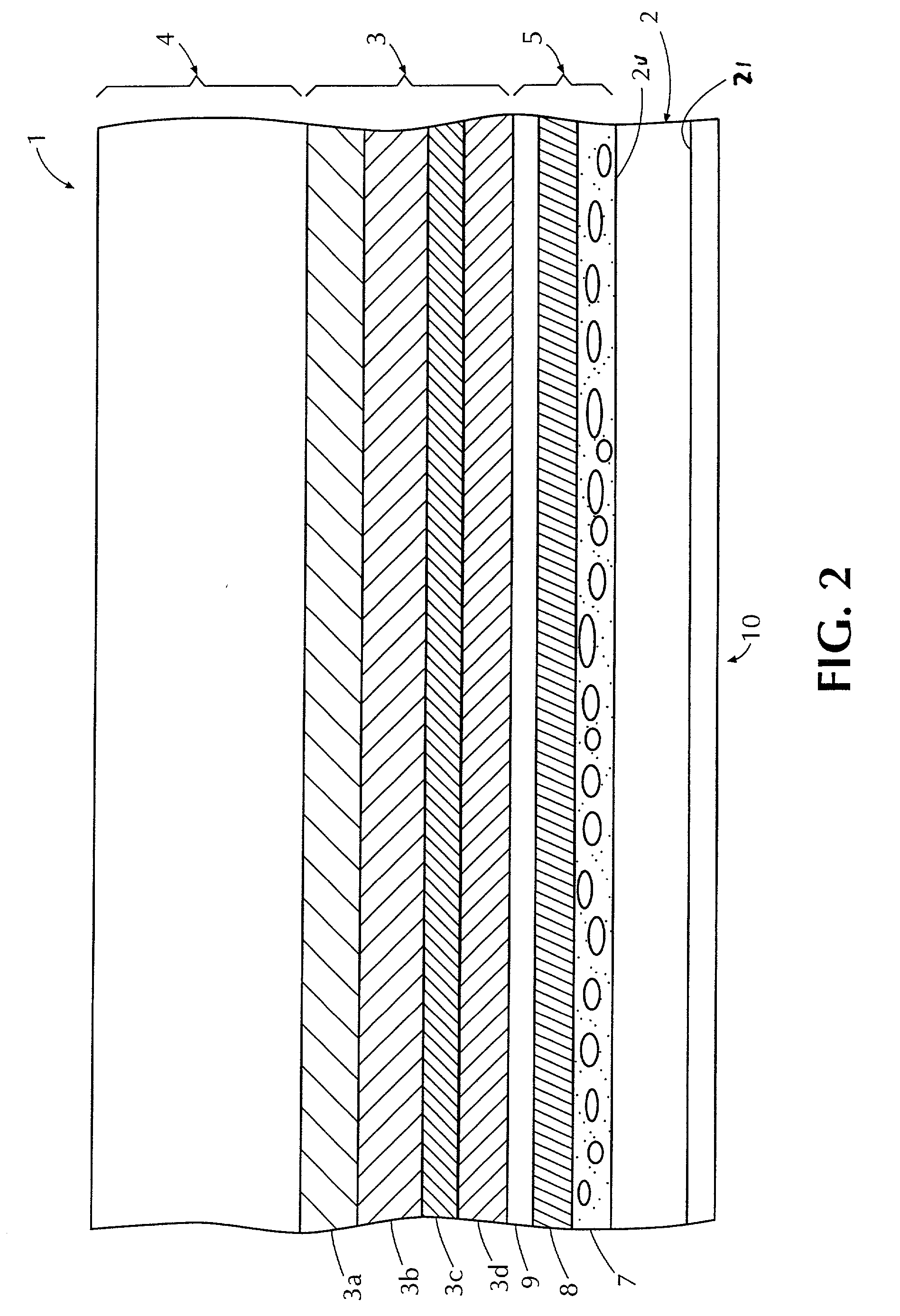Latex-based barrier for surface coverings
- Summary
- Abstract
- Description
- Claims
- Application Information
AI Technical Summary
Benefits of technology
Problems solved by technology
Method used
Image
Examples
example 1
[0045] A vinyl floor covering sample comprising the barrier layer was made by first applying 10 mil of nonfoamable plastisol to 30 mil felt substrate and gelling the nonfoamable plastisol in an oven at 200.degree. C. for 1.5 minutes in a horizontal position. Then, 18 mil of foamable plastisol was applied to the nonfoamable plastisol and the sample was gelled in an oven at 200.degree. C. for 1 minute in a horizontal position. 20 mil of a nonfoamable wearlayer plastisol was then applied on top of the foam layer and the sample was heated in an oven for 1 minute at 200.degree. C. in a horizontal position. No print was done on this foamable plastisol as this Example is just for testing the barrier properties. The sample was then heated in an oven at 200.degree. C. for 1 minute and 55 seconds in a vertical position with rotation in order to expand the foam, yielding an overall sample thickness of approximately 80 mil. Using Myer rod number 22, about 2 mil of the barrier composition set fo...
example 2
[0047] Floor covering material made in accordance with the materials and procedure described in Example 1 was prepared. Samples were then made and tested in accordance with Procedure 2. The test sample is denoted "DT Barrier EX 2". For comparison, a floor covering made by the procedure of Example 1 except without application of the barrier composition and subsequent heating was made and a sample of it was prepared and tested in accordance with Procedure 2. This comparative sample is denoted "DT No Barrier EX 2". Also, samples of three commercially available floor covering products, which are MANNINGTON iBACK.RTM., Congoleum ULTIMA.RTM. and ARMSTRONG TOUGH GUARD.RTM. were prepared and tested in accordance with Procedure 2. The results are shown in Table 3, below, expressed in terms of YI as a function of residence time at 70.degree. C.
3TABLE 3 YI Product (30 hours) YI (50 hours) YI (70 hours) DT Barrier EX 2 12.4 14.1 16.0 DT No Barrier EX 2 12.6 16.3 21.5 MANNINGTON iBACK .RTM. 25.3...
example 3
[0048] Floor covering material comprising a barrier layer was made by first applying 16 mil of foamable plastisol on a substrate of 20 mil fiberglass sheet pre-saturated with nonfoamable plastisol and heating in an oven at 200.degree. C. for 1 minute in a horizontal position to gel the foamable plastisol. Then, 18 mil of a nonfoamable wearlayer was applied to the foam layer and the sample was then gelled by heating in an oven for 1 minute at 200.degree. C. in a horizontal position and then for 1 minute and 55 seconds in a vertical position with rotation in order to expand the foam. 10 mil of a nonfoamable basecoat was then applied to the side of the sample opposite to the foam and the sample was again heated in an oven for 1 minute at 200.degree. C. in a horizontal position. Using a Myer rod number 22, about 2 mil of the barrier composition described in Example 1 was applied to the nonfoamable basecoat, and the entire sample was heated in an oven for 2 minutes at 200.degree. C. in a...
PUM
| Property | Measurement | Unit |
|---|---|---|
| Fraction | aaaaa | aaaaa |
| Fraction | aaaaa | aaaaa |
| Fraction | aaaaa | aaaaa |
Abstract
Description
Claims
Application Information
 Login to view more
Login to view more - R&D Engineer
- R&D Manager
- IP Professional
- Industry Leading Data Capabilities
- Powerful AI technology
- Patent DNA Extraction
Browse by: Latest US Patents, China's latest patents, Technical Efficacy Thesaurus, Application Domain, Technology Topic.
© 2024 PatSnap. All rights reserved.Legal|Privacy policy|Modern Slavery Act Transparency Statement|Sitemap


